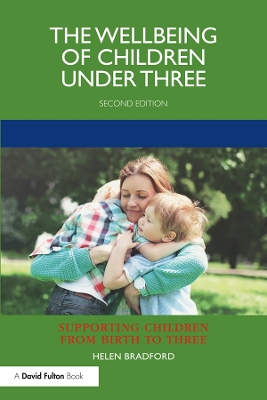Supporting Children from Birth to Three
4 total works
Now in an updated second edition, The Wellbeing of Children under Three unravels what wellbeing means for this age group by making clear links between research and effective early years practice. It looks at what wellbeing means for under threes in the light of key aspects of international social policy, and practically demonstrates how practitioners can support children in this area.
Focusing on the home-setting partnership with parents, work attitudes, adult–child interaction and quality learning environments, the book explores the role that adults play in holistically supporting children’s individual personal, social and emotional needs. This new edition also includes new material on practitioner mental health and the Leuven scales as a measure of wellbeing. Each chapter features:
- clear explanation of relevant theories
- case studies and examples of good practice
- focus points for readers
- questions for reflective practice
Providing a wealth of practical ideas and activities, this handy text encourages the exploration of all aspects of babies’ and toddlers’ wellbeing to help practitioners ensure effective outcomes for the youngest children in their care, and is essential reading for all those working with the under threes.
The most rapid and significant phase of development occurs in the first three years of a child's life. The Supporting Children from Birth to Three series focuses on the care and support of the very youngest children. Each book takes a key aspect of working with this age group and gives clear and detailed explanations of relevant theories together with practical examples to show how such theories translate into good working practice.
Effective planning and observation are fundamental to young children's learning and development. Learning opportunities for children need to be relevant for their age group, realistic and challenging.
Drawing on recent research, this book explains why the planning cycle is so important and looks at the links between observation, planning and assessment. Taking a holistic approach to supporting children's learning, it shows how a range of observation strategies can provide insight into children's social, emotional, physical and cognitive development and practically demonstrates how practitioners can develop appropriate planning and observation techniques for babies and toddlers.
Features include:
- clear explanation of relevant theories
- case studies and examples of good practice
- focus points for readers
- questions for reflective practice
Providing a wealth of practical ideas and activities, this handy text encourages explores all aspects of planning and observation with the under threes to help practitioners ensure effective outcomes for the youngest children in their care.
The most rapid and significant phase of development occurs in the first three years of a child's life. The Supporting Children from Birth to Three series focuses on the care and support of the youngest children. Each book takes a key aspect of working with this age group and gives clear and detailed explanations of relevant theories together with practical examples to show how such theories translate into good working practice.
It is widely known that babies and infants will flourish in an environment that supports and promotes their learning and development. But what constitutes an appropriate environment for children under three?
Drawing on recent research, this book explores the concept of an appropriate environment, both within and beyond the early years setting. It sets this within the context of child development and practically demonstrates how a high quality environment can be created for babies and children under three that supports their learning and development.
Features include:
- clear explanation of relevant theories
- case studies and examples of good practice
- focus points for readers
- questions for reflective practice
Providing a wealth of practical ideas and activities, this handy text provides detailed guidance on how to develop an appropriate indoor and outdoor environment for babies and children under three to help practitioners ensure effective outcomes for the youngest children in their care.



